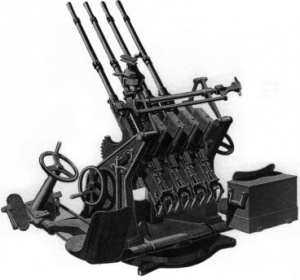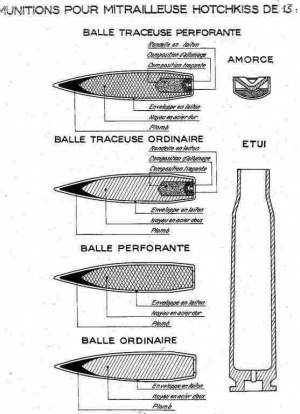Difference between revisions of "Hotchkiss Mle 1930 (13.2 mm)"
Inceptor57 (talk | contribs) m (→Comparison with analogues) |
Inceptor57 (talk | contribs) (→History: Placed in drop-down box so it does not clutter page) |
||
| Line 81: | Line 81: | ||
In the 1930s, the French cavalry mounted the 13.2 mm machine gun onto AMR.35 ZT1 reconnaissance vehicles to add some anti-tank capability to defend themselves during missions. This was also attempted on armoured cars such as the Laffly 80AM. Some machine guns were also exported arming anti-aircraft trucks, though the export attempt had little success with the only notable customer being Chile. | In the 1930s, the French cavalry mounted the 13.2 mm machine gun onto AMR.35 ZT1 reconnaissance vehicles to add some anti-tank capability to defend themselves during missions. This was also attempted on armoured cars such as the Laffly 80AM. Some machine guns were also exported arming anti-aircraft trucks, though the export attempt had little success with the only notable customer being Chile. | ||
| − | + | {{sp-begin|Hotchkiss Ammunition}} | |
| − | |||
{| class="wikitable" | {| class="wikitable" | ||
| Line 202: | Line 201: | ||
|} | |} | ||
[[File:13.2mm Ammunition.jpg|thumb|main combat rounds for the 13.2mm Hotchkiss]] | [[File:13.2mm Ammunition.jpg|thumb|main combat rounds for the 13.2mm Hotchkiss]] | ||
| − | + | <div style='text-align: left;'> | |
| − | + | ;'''Cartouche à balle ordinaire O or AP type O''' | |
it was a standard armour piercing rounds used against soft target such as infantry, unarmoured vehicles and aircraft. the projectile was made of carbon steel and was capped with lead. there was a brass cloak around the projectile. | it was a standard armour piercing rounds used against soft target such as infantry, unarmoured vehicles and aircraft. the projectile was made of carbon steel and was capped with lead. there was a brass cloak around the projectile. | ||
| Line 213: | Line 212: | ||
Velocity : 810 m/sec | Velocity : 810 m/sec | ||
| − | + | ;'''Cartouche à balle traçante OT or AP-T type OT''' | |
| − | |||
it was a standard rounds equipped with a tracer tail. it have the same ballistic as the Type O | it was a standard rounds equipped with a tracer tail. it have the same ballistic as the Type O | ||
can be identify by the primer seal painted Green | can be identify by the primer seal painted Green | ||
| − | + | ;'''Cartouche à balle perforante P or AP type P''' | |
this round was a armour piercing hardened round used against armoured target. the projectile was made of alloy Tungsten-steel (3% tungsten, 97% steel) and was tempered. there was a lead cap and brass cloak on the rounds | this round was a armour piercing hardened round used against armoured target. the projectile was made of alloy Tungsten-steel (3% tungsten, 97% steel) and was tempered. there was a lead cap and brass cloak on the rounds | ||
| Line 229: | Line 227: | ||
Velocity : 810 m/sec | Velocity : 810 m/sec | ||
| − | + | ;'''Cartouche à balle perforante traçante PT or AP-T type PT''' | |
it was a armour piercing rounds equipped with a tracer tail. it have the same ballistic as the Type P | it was a armour piercing rounds equipped with a tracer tail. it have the same ballistic as the Type P | ||
can be identify by the primer seal painted Yellow | can be identify by the primer seal painted Yellow | ||
| + | </div> | ||
| + | {{sp-end}} | ||
== Media == | == Media == | ||
Revision as of 03:40, 26 July 2022
Contents
Description
The 13.2 mm Hotchkiss Mle 1930 is a French-build heavy machine gun for multi-purpose use. Starting as Hotchkiss Mle 1929, the Mle 1930 is a ground-based anti-aircraft designation of the machine gun. It is commonly used as close anti-air defence by the French Navy and also by the French Infantry during the 30s until WW2. The guns was also adapted as main armament for tanks, armoured cars and anti-aircraft vehicles. The Hotchkiss was for France the equivalent of the M2 Browning heavy machine gun.
Vehicles equipped with this weapon
General info
The 13.2 mm Hotchkiss offer a good and balanced performance against aircraft and soft targets, but have difficulty against vehicles with more than 20 mm of armour. It feeds from a 30 rounds magazine, which would lead to the weapon's limited capacity to sustain a suppressing fire. The gun has a fire-rate of 450 rounds per minutes, but in practice it would seldom reach 20 rounds per minutes due to the reload and recoil.
Available ammunition
Only one belt is currently available for the Hotchkiss in the game, the AP-T belt.
AP-T belt composition: AP-I, API-T
| Penetration statistics | ||||||
|---|---|---|---|---|---|---|
| Belt | Penetration @ 0° Angle of Attack (mm) | |||||
| 10 m | 100 m | 500 m | 1,000 m | 1,500 m | 2,000 m | |
| AP-I | 24 | 23 | 14 | 10 | 7 | 4 |
| API-T | 24 | 23 | 14 | 10 | 7 | 4 |
| Belt details | ||||||||
|---|---|---|---|---|---|---|---|---|
| Belt | Velocity (m/s) |
Projectile Mass (kg) |
Fuse delay (m) |
Fuse sensitivity (mm) |
Explosive Mass (TNT equivalent) (g) |
Ricochet | ||
| 0% | 50% | 100% | ||||||
| AP-I | 800 | 0.05 | N/A | N/A | N/A | 47° | 56° | 65° |
| API-T | 800 | 0.05 | N/A | N/A | N/A | 47° | 56° | 65° |
Comparison with analogues
- M2HB (12.7 mm) - Similar gun in performance, but a lot more successful. It replaced the Hotchkiss 13.2mm after WW2 for standardization purpose.
- Type 93 (13.2 mm) - Japanese license copy of the Hotchkiss
- Breda Model 31 (13.2 mm) - Italian license copy of the Hotchkiss
Usage in battles
Describe the cannon/machine gun in the game - its distinctive features, tactics of usage against notable opponents. Please don't write a "guide" - do not impose a single point of view, but give the reader food for thought.
Pros and cons
Pros:
- Good fire-rate
- Effective against soft target
- Effective against aircraft
Cons:
- Penetration a bit lacking
- Magazine has only 30-rounds
History
Developed by Hotchkiss & Cie in the middle of the 20s, the Hotckiss Mle 1929 was a multi-purpose heavy machine gun. First used by the French Navy, it was serving as close anti-air defence for the ships for up to 2,500 meters. The Army also adopted the gun, but in the Mle 1930 variants. The difference was that the Mle 1930 wasn't equipped with the sight and mount that allow the machine-gun to be used against the aircraft. The reason was the French army worry about the bullets might fall back on civilian area and potentially kill someone. The Army strictly used this armament as anti-tank and anti-infantry weapons in their official services.
In the 1930s, the French cavalry mounted the 13.2 mm machine gun onto AMR.35 ZT1 reconnaissance vehicles to add some anti-tank capability to defend themselves during missions. This was also attempted on armoured cars such as the Laffly 80AM. Some machine guns were also exported arming anti-aircraft trucks, though the export attempt had little success with the only notable customer being Chile.
| Penetration statistics | |||||||
|---|---|---|---|---|---|---|---|
| Ammunition | Type of
warhead |
Penetration @ 0° Angle of Attack (mm) | |||||
| 10 m | 100 m | 500 m | 1,000 m | 1,500 m | 2,000 m | ||
| Type O | AP | 24 | 23 | 14 | 10 | 7 | 4 |
| Type OT | AP-T | 24 | 23 | 14 | 10 | 7 | 4 |
| Type P | APC | 28 | 27 | 20 | 15 | 11 | 9 |
| Type PT | APC-T | 28 | 27 | 20 | 15 | 11 | 9 |
| Shell details | |||||||||
|---|---|---|---|---|---|---|---|---|---|
| Ammunition | Type of
warhead |
Velocity
(m/s) |
Projectile
Mass (kg) |
Fuse delay
(m) |
Fuse sensitivity
(mm) |
Explosive Mass
(TNT equivalent) (g) |
Ricochet | ||
| 0% | 50% | 100% | |||||||
| Type O | AP | 810 | 0.051 | N/A | N/A | N/A | 66° | 70° | 72° |
| Type OT | AP-T | 810 | 0.051 | N/A | N/A | N/A | 66° | 70° | 72° |
| Type P | APC | 810 | 0.052 | N/A | N/A | N/A | 66° | 70° | 72° |
| Type PT | APC-T | 810 | 0.052 | N/A | N/A | N/A | 66° | 70° | 72° |
- Cartouche à balle ordinaire O or AP type O
it was a standard armour piercing rounds used against soft target such as infantry, unarmoured vehicles and aircraft. the projectile was made of carbon steel and was capped with lead. there was a brass cloak around the projectile.
can be identify by the primer seal painted either Black or Purple
projectile weight : 51,2 g
Velocity : 810 m/sec
- Cartouche à balle traçante OT or AP-T type OT
it was a standard rounds equipped with a tracer tail. it have the same ballistic as the Type O
can be identify by the primer seal painted Green
- Cartouche à balle perforante P or AP type P
this round was a armour piercing hardened round used against armoured target. the projectile was made of alloy Tungsten-steel (3% tungsten, 97% steel) and was tempered. there was a lead cap and brass cloak on the rounds
can be identify by primer seal painted Red
projectile weight : 52 g
Velocity : 810 m/sec
- Cartouche à balle perforante traçante PT or AP-T type PT
it was a armour piercing rounds equipped with a tracer tail. it have the same ballistic as the Type P
can be identify by the primer seal painted Yellow
Media
Excellent additions to the article would be video guides, screenshots from the game, and photos.
See also
Links to the articles on the War Thunder Wiki that you think will be useful for the reader, for example:
- reference to the article about the variant of the cannon/machine gun;
- references to approximate analogues by other nations and research trees.
External links
Paste links to sources and external resources, such as:
| France anti-aircraft guns | |
|---|---|
| 13.2 mm | Hotchkiss Mle 1930 |
| 20 mm | GIAT M693/mod F2 · Oerlikon KAD (Swiss) |
| 30 mm | HSS 831A |
| 40 mm | Bofors L/60 · Mle. 1951 T1 (Bofors L/70) |





